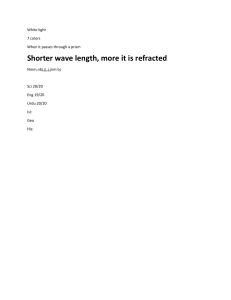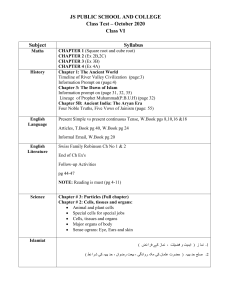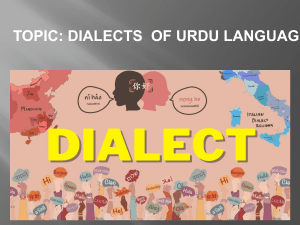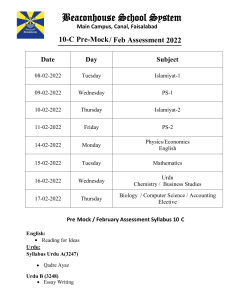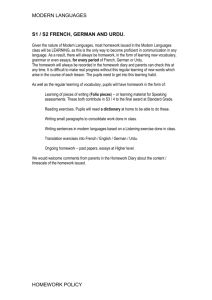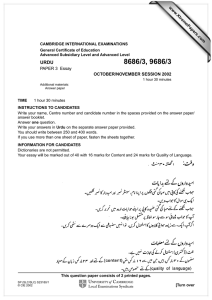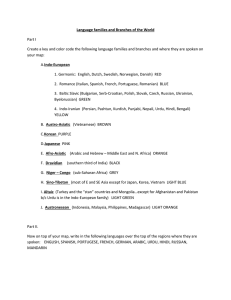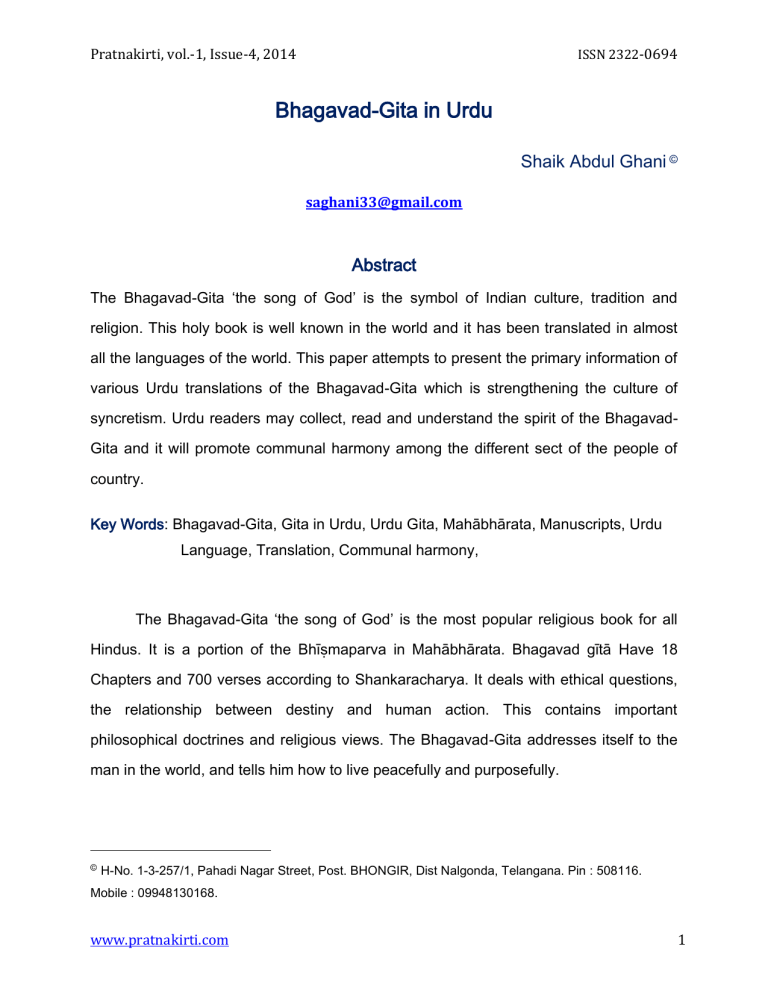
Pratnakirti, vol.-1, Issue-4, 2014 ISSN 2322-0694 Bhagavad-Gita in Urdu Shaik Abdul Ghani © saghani33@gmail.com Abstract The Bhagavad-Gita ‘the song of God’ is the symbol of Indian culture, tradition and religion. This holy book is well known in the world and it has been translated in almost all the languages of the world. This paper attempts to present the primary information of various Urdu translations of the Bhagavad-Gita which is strengthening the culture of syncretism. Urdu readers may collect, read and understand the spirit of the BhagavadGita and it will promote communal harmony among the different sect of the people of country. Key Words: Bhagavad-Gita, Gita in Urdu, Urdu Gita, Mahābhārata, Manuscripts, Urdu Language, Translation, Communal harmony, The Bhagavad-Gita ‘the song of God’ is the most popular religious book for all Hindus. It is a portion of the Bhīṣmaparva in Mahābhārata. Bhagavad gītā Have 18 Chapters and 700 verses according to Shankaracharya. It deals with ethical questions, the relationship between destiny and human action. This contains important philosophical doctrines and religious views. The Bhagavad-Gita addresses itself to the man in the world, and tells him how to live peacefully and purposefully. © H-No. 1-3-257/1, Pahadi Nagar Street, Post. BHONGIR, Dist Nalgonda, Telangana. Pin : 508116. Mobile : 09948130168. www.pratnakirti.com 1 Pratnakirti, vol.-1, Issue-4, 2014 ISSN 2322-0694 The popularity and importance of the Bhagavad-Gita is evident from the fact that innumerable manuscripts have been preserved. In 1809, it was printed for the first time from Calcutta. The Bhagavad-Gita won many admirers in India and as well as abroad. Charles Wilkins (1750-1836), one of the founder fathers of the Asiatic society translated the Bhagavad-Gita into English and published it from London in 1885. It was well accepted and warmly received by the English speaking world. In 1823 Schlegel brought out a critical edition of the Bhagavad-Gita in Devanagari script with a Latin translation. It was translated into Russian by N.I.Novikov. The Bhagavad-Gita was translated into German language many times, by C.R.S. Peiper in 1834, by Fr. Lorinser in 1869, and by R. Boxberger in 1870. It was translated into other European languages also. There are many other English translations also available. During the Muslim rule in India, many Sanskrit works were translated into Persian under the patronage of the Mughals and other rulers. The Bhagavad-Gita was translated into Persian as the part of razmnama (the book of war); Persian translation of the Mahabharata which was done by the translators of the court. Abul Fazl wrote the preface of translation of the Mahabharata and translated Bhagavad-Gita into Persian. Sheikh Faizi also translated Bhagavad-Gita. Prince Darashikoh (1615-1659); son of Shahjahan translated Bhagavad-Gita into Persian with the help of Sanskrit Pandits. Another version of Sufi interpretation of the Bhagavad-Gita entitled as the Mir’at-ulHaqa’iq (the Mirror of realities) with comparative comments in Islamic terminology on its philosophic importance by Abdul Rahman Chishti in 1065 A.H (1654 AD). The Bhagavad-Gita was translated into Arabic by Dr Makhan Lal Roy Choudhury; Head of the Department of Islamic History and Culture in the University of Calcutta. It was published by the M/s Thacker Spink &co Ltd Calcutta in 1933. It was www.pratnakirti.com 2 Pratnakirti, vol.-1, Issue-4, 2014 ISSN 2322-0694 printed at the Dairatul Ma’arifil Osmania Press, Hyderabad in 1951. It has preserved in well manner at library of Dairatul Ma’arifil Osmania, Osmania University. Hyderabad (Telangana). The Bhagavad-Gita was translated in almost all the Indian languages. It shows its popularity and interest of the Indian society towards it. A translation in general is meant for those who do not know the original language. It is effective when it is translated into the language using the idioms and style of the targeted language. Most of the Urdu translators do not know Sanskrit language; they use Hindi or English versions for their translation. The earliest Urdu translation of the Bhagavad-Gita was done in Dakhni. Syed Yahya Nasheet mentions a Dakhni poet Syed Mubin’s (17th Century) translation called kṛṣṇagītā, arjunagītā There are two Urdu translations; those exist on the basis of Faizi’s Persian translation of the Bhagavad-Gita. One is done by Lakshmi Prasad Sadar with a title of ‘sadar ki gita’ which was published in 1910 AD. Another is translated by Alam Muzafar Nagari with a title ‘irfan e maqtum’ and published in 1960 AD. A large number of Urdu translations of the Bhagavad-Gita is available. Most of the information about the Bhagavad-Gita collected from the primary and secondary sources. Many of them do not exist today. The list of translations is under-mentioned: • Bhagavad-Gita’s early Urdu translation in prose composed by Kanhaiyalal Alakh Vihari with a title Gyan Prakash and published from Gyani Press, Akbarabad, Agra (Uttar Pradesh) in 1863. • Bhagavad-Gita translated by Munshi Shyam Sunderlal Banarsi and published from Naval Kishore Press, Luckhnow (Uttar Pradesh) in 1884. www.pratnakirti.com 3 Pratnakirti, vol.-1, Issue-4, 2014 • ISSN 2322-0694 Bhagavad-Gita into simple Urdu language translated by Munshi Devi Prasad and published from the Ram Press, Meerut (Utter Pradesh) in 1913. • Bhagavad-Gita translated by Munshi Ram Sahay and published by Naval Kishore Press, Lucknow (Uttar Pradesh) in 1913. • Bhagavad-Gita translated into Urdu by Qazi Mohammad Nayyar Siddiqi with a title Israr-e-ma’rifat which is published from Sevak Seyam press, Lahore in 1915. • Bhagavad-Gita translated into Urdu prose by Pandit Janakinath Madan Dehalvi with a title falsafa uluhiyat, its fifth edition published from Ram Narayan press, Mathura (Uttar Pradesh) in 1922. • Bhagavad-Gita translated into Urdu by Munshi Jagannath Prasad Arif with a title Sarchashma Irfan and published by Nami Press, Meerut (Uttar Pradesh) in 1925. • Bhagavad-Gita and Lokamanya Balagangadhar Tilak’s Gita Rahasya translated byShanti Narayan; these two books were published in one volume from Amrut press Lahore in 1925. In the first book include discussions on teachings of Gita, second is the simple Urdu translation of Bhagavad-Gita Shlokas. • Srimad Bhagavad-Gita translated into Urdu by Munshi Kedarnath with the title Rahe-maghfirat and published by Mehtab Press, Delhi in 1926. • Bhagavad-Gita into Urdu translated by Babu Bhagvan Das Bhargav and published from Naval Kishore press, Lucknow (Uttar Pradesh) in 1927. • Bhagavad-Gita into Urdu translated by Choudhary Roshanlal with a title Gita Amrut which is famous as akseer-e-rooh. www.pratnakirti.com 4 Pratnakirti, vol.-1, Issue-4, 2014 • ISSN 2322-0694 Bhagavad-Gita translation into Urdu poetry made by Pandit Yogiraj Nazar Sohanvi with a title kalaam-e-rabbaani, published by Mahboobul Matabah, Barqi press Jamia Masjid, Delhi. • Bhagavad-Gita translated into Urdu by Pandit Roop Narayan Panday with a title Srimad Bhagavad-Gita and published from Lucknow (Uttar Pradesh) in 1941. • Srimad Bhagavad-Gita translated into Urdu by Bankat Prasad Khaleeq with the title Makhzan Gyan and Anand Prakash published by Putr Narsingh Raj kapoor from Azam Steem Press, Hyderabad Deccan (Telangana) in 1945. • Bhagavad-Gita translated into Urdu poetry by Basweshwar Prasad Munavvar lakhnavi with a title Naseem Irfan and published by Adarsh Kitab Ghar, Delhi in 1955. • Bhagavad-Gita Urdu prose translation by Pandit Laxminarayan Mishra and published by Anjuman Taraqqi Urdu (Hind), Hyderabad (Telangana). • Bhagavad-Gita translated into Urdu poetry by Satya Prakash Sarvari with a title Gita Hindustani Nazm mein which is published by Naveentam Prakashan, Shankar Bhavan, Shahadra Delhi in 1964. • Bhagavad-Gita translated into Urdu prose by Hasnuddin Ahmed with a title ‘Naghma-e-Uluhiyat’ and was published by National Book Trust, India. New Delhi in 1975. Dr. Hasanuddin Ahmed is a retired IAS officer. This well-known Hyderabadi translated the sacred text of Hinduism in 1945 during the reign of the seventh Nizam, Mir Osman Ali Khan. And it remains popular even to this day because of the scholarly work and lucidity of expression. Dr. Ahmed wrote ‘Naghma-e- www.pratnakirti.com 5 Pratnakirti, vol.-1, Issue-4, 2014 ISSN 2322-0694 Uluhiat' soon after joining the Nizam's service as Assistant Director of the Ecclesiastical Department. The Ecclesiastical Department was responsible for the issue of grants and maintenance of places of worship of all religions and not just mosques. “The Department was more secular and treated all religions equally,” says Dr. Ahmed who served as its last director. He has a passion for comparative study of religions. Though he did not know Sanskrit, he overcame the problem with the help of lexicon and works of Edwin Arnold and Annie Besant. His perfect translation of the 701 shlokas in 18 chapters has come in with high appreciation. Several editions of his book have come out over the years and in 1975, former Prime Minister, Indira Gandhi, released one of them. • Srimad Bhagavad-Gita translated into Urdu by Charandas Reddy and published by Shri Bhagavat Ashram, Both, Adilabad District (Telangana) in1983. • Bhagavad-Gita translated into Urdu Poetry by Sarwanand Kaul Premi and published from Delhi in 1992. Special character of this translation is that the translator merely tries to use a lot of Urdu Idioms in his translation. For example; स । ।।1.19 sa ghoṣo dhārtarāṣṭrāṇāṃ hṛdayāni vyavadārayat nabhaśca pṛthavīṃ caiva tumulo abhyanunādayan . www.pratnakirti.com 6 Pratnakirti, vol.-1, Issue-4, 2014 ISSN 2322-0694 وشر و رش ااسی واہں رپ یک ملق بریاوہا ہی رنیم ہی آامسں اور ہی رلر ہی ااہت وشرولغ نس نس ےک وکرو اک رگج ےنٹھپ اگل ہر رطف بب وکرو یک وفج ںیم اھچیئ نشا Shor o shar aisa vahaan par yak qalam barpaa hua. zameen ye asmaan aur ye larz ye inteha Shor o ghul sun sun ke kaurav ka jigar phatne laga. Har taraf tab kaurav ki fauj mein chayi nasha. ओ स स ओ फ़ कख़ औ स स कक क । । क क । । There are two idioms in first and third line appeared i.e. ( )برپاوہاbarpa hua (happened) and jigar phatne laga (having sorrow). • Srimad Bhagavad-Gita translated into Urdu prose by STV. Appalachari with the title Naghma-Ilahi and published from Geeta press, Gorakhpur (Uttar Pradesh) in 2003. Appalachary hailed from Hyderabad and he was a retired Statistical Officer in Education Department in Hyderabad (Telangana). • Bhagavad-Gita translated into Urdu by Abdul Azeez Khalid which is published from Anjuman Taraqqi Urdu (Pakistan) Karachi. • Bhagavad-Gita translated into Urdu poetry by Khalifa Abdul Hakeem with a title Tarjuma Gita and printed at Ittehad press, Lahore www.pratnakirti.com 7 Pratnakirti, vol.-1, Issue-4, 2014 • ISSN 2322-0694 Bhagavad-Gita translated into Urdu poetry by Sultan Ahmed Siddiqi Gorakhpuri with a title Gita Manzoom and published by Hiralal Bhatnagar. • Srimad Bhagavad-Gita translated into Urdu in two volumes by Maharshi Shivbrat Lal and published from Saleemi Barqi press Allahabad (Uttar Pradesh). • Shrimad Bhagavad-Gita translated into Urdu poetry by Pandit Prabhu Dayal A’shiq Lakhnavi with a title Ghiza-e-Rooh. • Bhagavad-Gita also translated into Urdu Poetry by Suraj Narayan Mehar Dehalavi with a title Falsafa Gita. • Bhagavad-Gita translated into Urdu Poetry by Shanul Haq Haqqi and was published by Anjuman Taraqqi Urdu (Hind), New Delhi in 1994. And also published from Fazli sons (private) limited, Urdu Bazar, Karachi (Pakistan) in 2006. It is treated one of the best translations available in Urdu. He adopted Urdu poetic style. For exampleस स स क क क स । ।। 3.19 tasmādasaktaḥ satataṃ kāryaṃ karma samācara asakto hyācaran karmaṃ paramāpnoti pūruṣaḥ . وہ وہرک ےب اینر اےنپ لمع ےک ارجا ےس رسکی رکے اگ رگ ریاتض وت رےہ اگ الضف و بررت Vo hokar be niyaaz apne amal ke ijra se yaksar Karega gar riyaazat to rahega afzal va bartar. www.pratnakirti.com 8 Pratnakirti, vol.-1, Issue-4, 2014 ISSN 2322-0694 क क स स । क • । Bhagavad-Gita translated into Urdu by Mohammad Ajmal Khan with a title “Naghma-Qudaavandi” and published by Anjuman Taraqqi Urdu (Hind) Aligarh (Uttar Pradesh) in 1959. Its first edition was published from Idara Navamees Ilahia, Allahabad (Uttar Pradesh) in 1935. He tries to explain Hindu philosophy with the Sufi terminology. For exampleक स । स क ।।11.17 kirīṭinaṃ gadinaṃ cakriṇaṃ ca tejorāśiṃ sarvato dīptimantam paśyāmi tvāṃ durnirīkṣyaṃ samantād dīptānalārkadyutimaprameyam . ےھجم رگر (رکچ) اور رتوشیل رظن آرےہ ںیہ۔ وج آگ یک رطج رونش،ںیم داتھکی وہں ہک ہر ہگج جالل یہ جالل ےہ ںیہ اور آاتفب یک روینش یک رطج رظن وک ریخہ رکےت ںیہ۔ ال دحمود اضف ںیم ہر رطف ریتا یہ ولجہ ےہ۔ Main dekhta hun ke har jagha jalaal hi jalaal hai, mujhe garz (chakr) aur tirshul nazar aarahe hain. Jo aag ki tarah raushan hain aur a’ftab ki raushni ki tarha nazar ko khira karte hain. La mahdud fiza men har taraf tera hi jalwa hai.11.17 “ क क , औ फ़ क ( क )औ क ख़ । क । ।’’ Also he compared this meaning with the similar Urdu verse of renowned Urdu poet Maulana Altaf Hussain Hali— اکلم ےہ وج ارل ےس وہ ےہ امکل ریتا یایق ےہ وج ادب یک وہ ےہ جالل ریتا www.pratnakirti.com 9 Pratnakirti, vol.-1, Issue-4, 2014 ISSN 2322-0694 Kaamil hai jo azal se vo hai kamaal tera Baqi hai jo abd tak vo hai jalaal tera. क स क क • । Bhagavad-Gita translated into Urdu poetry by Khan Bahadur Mirza Jafar Ali Khan Asar with the title ‘Naghma Javed’ and published by Raj Mahal Publishers, Jammu (Jammu Kashmir). • Bhagavad-Gita translated into Urdu poetry by Khwaja Dil Mohammad with the title ‘Dil- Ki- Gita’ and published by National Council for Promotion of Urdu Language, New Delhi in 2004. First time this translation was published from Azad Book Depot Amritsar (Punjab). Merely he translated in Urdu poetry with simple and attractive style which is easy to understand. For example- ےھجت رکم رکیا ےہ او رمد اک ر ےھجت اایتخر،ںیہن اس ےک لھپ رپ ےیک اج لمع اور ہن دوھیڈ ااکس لھپ ہن وہ ےب لمع، لمع رک،لمع رک Tujhe karm karna hai o marde kaar Nahin iske phal par, tujhe eqtiyar Kiye ja amal aur na dhundh iska phal Amal kar, amal kar, na ho be amal. क क क www.pratnakirti.com ओ औ क , सक सक , क , क , । 10 Pratnakirti, vol.-1, Issue-4, 2014 • ISSN 2322-0694 Bhagavad-Gita translated into Urdu poetry by poet Anwar Jalalpuri of Bara Banki in Uttar Pradesh and titled Urdu Shaairy mein Gita has been published. Bhagavad-Gita contains 701 shlokas and to explain its meanings in simple and easy language it has been expanded to 1761 couplets by him. It is published in Nagari script. Persue the an example in Urdu translation from prose and poetry for the following Shloka of Bhagavad-Gitaस स: क : क स सक । स क ।। sannyāsaḥ karmayogaśca niḥśreyasakarāvubhau tayostu karmasannyāsāt karmayogo viśiṣyate . 5.2 Translation of Dil Mohammad is as follows: وگھباں ےن رھپہی یاب،یہک نس ےک ںیہ رتک اور لمع دوونں راہ اجنب فضیلت ںیم نکیل ےہ برھ رک لمع ہک رتک لمع ےس ےہ رتہب لمع Kahi, sunke, bhagvaan ne phir ye baat. Hain tark aur amal donon rahe najaat. Fazeelat mein lekin hai badhkar amal. Ke tark amal se hai behtar amal क फ़ www.pratnakirti.com स क , क ढ़क कऔ ,क क स । 11 Pratnakirti, vol.-1, Issue-4, 2014 ISSN 2322-0694 Translation of Dr.Hasnuddin Ahmed is as follows: نق رتک لمع اور ےب رغض اکم دوونں رواحین رسمب یک ےل اجےت ںیہ۔ دوونں ںیم یھب ےب رغض اکم ینن رتک اامعل ےس رتہب ےہ۔ Tarke a’mal aur be gharz kaam donon roohani masarrat tak lejate hain, Donon mein bhi be gharz kaam yaqeenan tark-e a’mal se behtar hai. क स औ क स क । क क । (The Yoga of knowledge and the Yoga of Action both lead to supreme Bliss.Of the two; however, the Yoga of Action (being easier of practice) is superior to the Yoga of Knowledge) Here we can see the example for these two Shlokas of Bhagavad-Gita translated by various Urdu translators; and we can understand the different styles of translation and its lucidity. । स क स । स स ।।4.7 ।।4.8 yadā yadā hi dharmasya glānirbhavati bhārata। abhyutthānamadharmasya tadātmānaṃ sṛjāmyaham . paritrāṇāya sādhūnāṃ vināśāya ca duṣkṛtām dharmasaṃsthāpanārthāya sambhavāmi yuge yuge. Translation of Dr.Husnuddin Ahmed is as follows: www.pratnakirti.com 12 Pratnakirti, vol.-1, Issue-4, 2014 ISSN 2322-0694 اے اھبرب جت یھبک قح (درھم) وک روال آیا ےہ۔ اور یالط (ادرھم) وک فروغ وہیا ےہ۔ وت ںیم امنیاں وھاجیا وہں۔ راست یار یک افحتظ رجکو یک ابتیہ اور قح (درھم) وک وبضمیط ےک ساھت اقمئ رکےن ےک ےیل ںیم فلتخم رامونں ںیم آیا ایگ وہں Ay bhaarat jab kabhi haq (dharm) ko zawaal aata hai, aur baatil (adharm) ko farugh hota hai, to main numaayaan ho jata hun. Rast baz ki hifaazat kajru ki tabaahi aur haq (dharm) ko mazbuti ke saath qaayam karne ke liye main muqtalif zamaanon mein aaya gaya hun. “ क । क ( क )क फ़ औ क फ़ क औ ( ( )क फ़ )क , कस क ।’’ Translation of Bhagvandas is as follows: ےہ اھبرب جت جت درھم یک یتٹھگ وہیت ےہ۔اور ادرھم یک رتیق وہیت ےہ۔ بب ںیم منج اتیل وہں۔ ںیم یگ یگ ںیم منج اتیل وہں، دوٹش ولوگں ےک یاس رکےن اور درھم وک اقمئ رےنھک ےک ےیل،نجس ولوگں عک اچبےن He bhaarat jab jab dharm ki ghatti hoti hai. Aur adharm ki taraqqi hoti hai, tab main janam leta hun. Sajjan logon ke bachaane, dusht logon ke naas karne aur dharm ko qaayam rakhne ke liye, main yug yug mein janam leta hun “ स क क , ,औ क सक क औ , क क । , - ।“ Translation of Appalachary is as follows: بب ںیم اانپ وہظر رکیا وہں۔ ینعی داین ںیم، اور ادرھم براتھاجیا ےہ،اے ارنج! جت جت درھم وک جطرہ دیپا وہیا ےہ اویار یک لکش ںیم امنیاں وہیا وہں۔ www.pratnakirti.com 13 Pratnakirti, vol.-1, Issue-4, 2014 ISSN 2322-0694 سادوھوں ینعی بیک اکروں یک افحتظ اور دباکر ینعی گیاہ اگروں وک تسین ویاوبد رکےن ےک ےیل اور درھم وک اقمئ رےنھک ےک ےیل ںیم s یگ یگ ںیم ینعی ہر دہع ںیم اویار اتیلوہں۔ ینعی انشاین وصرب ںیم وہظر یڈری وہیا وہں۔ “Ay- arjun Jab jab dharm ko khatra paida hota hai, aur adharm badhta jaataa hai, tab main apnaa zahoor kartaa hun. Yani duniya mein avataar ki shakal mein numayaan hota hun”. “Sadhuvon yani nek karon ki hifaazat aur badkaar yani gunhagaron ko neest va nabood karne ke liye, aur dharm ko qayam rakhne ke liye main yug yug mein yani har ahad mein avataar leta hun. Yani insaani surat mein zahoor pazeer hota hun”. क ख़ क स कक क क क फ़ औ ,औ ढ़ । क । क । क क । स क ,औ स । Translation of Shanul Haque Haqqi is as follows: است اک جت یھب وہہبلغ،اہجں ںیم درھم جت ڑگبے وت آیا وہں ںیم ارنج! وبل رکےن درھم اک یاال ب جال آیا وہں ھکتوں وک ہر یگ آرسا دےنی رشریوں وک زسا دےنی،براھےن درھم یک یتکش Jahaan mein dharm jab bigde, asat ka jab bhi ho ghalb To aata hun main arjun! Bol karne dharm ka baala. Chalaa aata hun main bhakton ko har yug asraa dene Badhane dharm ki shakti, shareeron ko sazaa dene. www.pratnakirti.com 14 Pratnakirti, vol.-1, Issue-4, 2014 ISSN 2322-0694 , स क ! क क क ढ़ क , । स क स । (Arjuna, whenever righteousness is on the decline, and unrighteousness is in the ascendant, then I body myself forth. For the protection of the virtuous, for the extirpation of the evil- doers, and for establishing dharma (righteousness) on a firm footing. I am born from age to age.) ☯ References: 1. Ali. Dr. Saheb, 2009 A.D., Urdu men Gita ke tarajim, Ed. prof Qamar Rais, Hinduatani Asaateer aur Fikr o Falsafa ka Asar Urdu zaban o Adab par, Urdu Academy, Delhi. 2. Faruqi, Dr. Shamsur Rahman, 2008 A.D., Urdu Literary Culture: The Syncretic Tradition,, Shibli Academy, Azamgarh, (Utter Pradesh). 3. Gita translation into Urdu poetry, The Milli Gazette, August 2014, pages: 1-15. 4. Hasrat, Dr. Bikramjit, 1982 A.D., Darashikuh: Life and Works, Munshiram Manoharlal Publishers Pvt Ltd., New Delhi http://www.thehindu.com/news/cities/Hyderabad/now-read-bhagavad-gita-fromright-to-left/article2915419.ece http://www.thehindu.com/todays-paper/tp-national/tp-andhrapradesh/gitas-urdutranslator-pined-by-religious-madness/article3368582.ece www.pratnakirti.com 15 Pratnakirti, vol.-1, Issue-4, 2014 ISSN 2322-0694 5. Jayadayal, Goyandka, Srimad Bhagavad Gita, 2006 A.D., Gita press, Gorakhpur (Utter Pradesh). 6. Nabhavi Ramlal, Reviw of Bhagavadgita Urdu, Ajkal (Urdu) June 1994 A.D., Journal of Publication Division, New Delhi. 7. Nabhavi Ramlal, Urdu translations of Sanskrit Works, M’arif (Urdu) April-june, 1994 A.D., Journal of Darul Musannifin, Azamgarh, (Utter Pradesh). 8. Sengupta, Gauranga Gopal. Sovenir of XXXIII All India Oriental Conference, 1986. The Asiatic Society, Culcutta. 9. Shaik, Abdul Ghani, 2009 A.D., Sanskrit Literature Rendered into Urdu, Sanskrit Academy, Osmania University Hyderabad and DK print World (P) Ltd, New Delhi, www.pratnakirti.com 16
